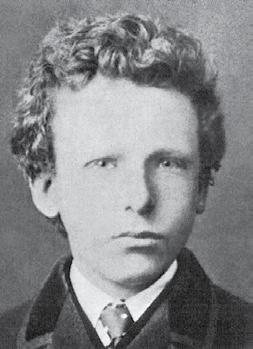
2 minute read
Early life
from Nishi Mundra
Vincent Van Gogh, 1866
Vincent Willem van Gogh was born on 30 March 1853 into a Dutch Reformed Church family in Groot-Zundert, in the predominantly Catholic province of North Brabant in the Netherlands. He was the oldest surviving child of Theodorus van Gogh, a minister of the Dutch Reformed Church, and Anna Cornelia Carbentus. Van Gogh was given the name of his grandfather, and of a brother stillborn exactly a year before his birth. Van Gogh’s mother was a rigid and religious woman who emphasised the importance of family to the point of claustrophobia for those around her. Theodorus’s salary was modest, but the
Advertisement
Church supplied the family with a house, a maid, two cooks, a gardener, a carriage and horse, and Anna instilled in the children a duty to uphold the family’s high social position.
Van Gogh was a serious and thoughtful child. He was taught at home by his mother and a governess, and in 1860 was sent to the village school. In 1864, he was placed in a boarding school at Zevenbergen, where he felt abandoned, and campaigned to come home. Instead, in 1866 his parents sent him to the middle school in Tilburg, where he was deeply unhappy. His interest in art began at a young age. He was encouraged to draw as a child by his mother, and his early drawings are expressive, but do not approach the intensity of his later work. In July 1869 Van Gogh’s uncle Cent obtained a position for him at the art dealers Goupil & Cie in The Hague. After completing his training in 1873, he was transferred to Goupil’s London branch on Southampton Street, and took lodgings at 87 Hackford Road, Stockwell. This was a happy time for Van Gogh; he was successful at work, and at 20 was earning more than his father. Theo’s wife later remarked that this was the best year of Vincent’s life.
At age 15, van Gogh’s family was struggling financially, and he was forced to leave school and go to work. He got a job at his Uncle Cornelis’ art dealership, Goupil & Cie., a firm of art dealers in The Hague. By this time, van Gogh was fluent in French, German and English, as well as his native Dutch.
In June of 1873, van Gogh was transferred to the Groupil Gallery in London. There, he fell in love with English culture. He visited art galleries in his spare time, and also became a fan of the writings of Charles Dickens and George Eliot.










